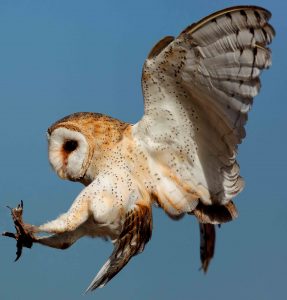 Owls sometimes seem like birds of paradox, as some of the most common denizens of our woods yet some of the least seen. The paradox arises because they are primarily birds of the night, when we humans are generally not out and about observing. Of course, many species can be seen by day, but the Barn Owl is one of the most nocturnal. Its stealthy night-time habits, combined with its unusual “monkey” face, has made it a common harbinger of the mysterious, the occult, the sinister, ghostlike, and vaguely evil.
Owls sometimes seem like birds of paradox, as some of the most common denizens of our woods yet some of the least seen. The paradox arises because they are primarily birds of the night, when we humans are generally not out and about observing. Of course, many species can be seen by day, but the Barn Owl is one of the most nocturnal. Its stealthy night-time habits, combined with its unusual “monkey” face, has made it a common harbinger of the mysterious, the occult, the sinister, ghostlike, and vaguely evil.
Barn Owls constitute a single cosmopolitan species, widely distributed and native to most of North America, irregularly to the northern states and Canada. It is a lowland species that thrives in farmland, grassland, deserts, and some marshes. Pete Dunne notes that you are most likely to see one as it flushes from a structure you’ve just intruded into, or perhaps caught at the edge of your headlight beam as it flies in open country. Barn Owls do, indeed, commonly nest in structures such as barns, raising the interesting question of where they nested before humans built such structures. A. C. Bent, admitting he has had little personal knowledge of the species, quotes Bendire, from 1892: “Their nesting sites . . . include all sorts of places, such as natural hollows in trees, holes and cavities in clay banks and cliffs, burrows underground enlarged to suit their needs, in the sides of old wells, abandoned mining shafts, dovecots, barns, church steeples, etc.” and even rarely on the exposed roof of a building. Local observers taking part in the Pigeon Guillemot study have reported Barn Owls nesting in the same cliff areas as the Guillemots.
A female commonly lays five to seven eggs at a time, at intervals of a few days, so the emerging nestlings vary considerably in age. Both parents incubate the eggs and are sometimes found incubating side by side, with the eggs spread beneath them. The young tend to be a noisy, very active, and pugnacious lot, fighting with one another and making strange noises. They remain in the nest for about 7-8 weeks after hatching, but may stay in the nearby trees where the parents continue to feed them. Their parents bring in abundant food of various small mammals, most commonly mice of different species, and so have traditionally been considered beneficial to agriculture. (by Burt Guttman, Barn Owl Photo – courtesy Carlos Delgado)







